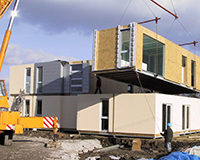The answer to the housing crisis could be the overdue rise of modular development, as long as the government backs the build-to rent sector. Jay Das assembles the argument
We are about to witness the beginnings of a major shift in how houses are built in England. Mortar, concrete and bricks have evaded the technological revolution for many decades beyond what anyone could forecast. But the UK’s decision to leave Europe is about to herald a new era in housing construction. A cocktail of scarcity in funding for housing, increasingly complex planning and environmental requirements, an anticipated shortage of manual labourers, a likely increase in the cost of building materials (expected to be experienced following Brexit) and an ever widening gap between supply and demand for housing is about to herald in the era of “modular” homes.
Driving forward
Those promoting modular construction compare it to the motor trade. The basic components of a car are well known and understood, beyond which, it is the “frills” – the colour, the shape, the size – which determine the final product. And so, with housing, it will be these finishing touches – the size and design of the windows and roofs, the interiors in terms of mood lighting and underfloor heating, etc – which will distinguish one house from the next on the same development.
Modular construction can be said to have emanated from the “prefabricated” era. The houses are manufactured in a warehouse where each element of the construction process is segmented and compartmentalised for ease of processing and manufacturing. A house, for example, can be modelled so that the ground floor, the first floor and the roof can be constructed in separate sections of the whole, transported to the site, concreted in place and put together. All elements of the external and internal parts of the house will be completed, including the internal décor, electrics and paint, and even the wooden flooring and kitchen units can be finished in the warehouse before being transported to the site.
It is said that the manufacturing of the homes in warehouse conditions, unaffected by the delays caused by weather and a varied labouring workforce, can save as much as six months. Some examples cite being able to put the units together on-site within seven days, provided the preparatory foundation and connectivity works have been pre-completed.
Why has it taken so long?
Modular construction has been around for some time and questions have been raised as to why it has had so little traction to date. There are many explanations, such as the fact that its predecessor, “prefab” housing, suffered from its association with cheap and poor quality construction. The sector has battled long and hard to adopt its new description of “modular” housing with immense focus being concentrated on better quality and design and the achievement of superior sustainability standards which it is maintained can only be achieved in a factory environment, not to mention the speed with which these units can be constructed on site.
The other great stumbling block was the lack of investment in “production-style” housing, which requires significant upfront investment in warehouses and machinery, as well as heavy demand for its output in order to make the proposal economically viable. In addition to this, it was known that houses for sale could only be sold at a certain speed and there was little reason to construct houses in seven days only to have them sitting there waiting to be sold.
The rental revolution
Investors in housing development are looking to enter the build-to-rent market, where the period from construction to rent is considerably shorter. This will enable investment funds to invest early and reap the benefits of a short construction process. It is believed that the circumstances are now ripe for the government to extend its support to this relatively new form of housing tenure.
The current economic circumstances and the housing crisis – in terms of shortage of housing and a notion of a more predictable return in housing investment in the UK in the medium to long term – has meant that investment funds are beginning to look at the use of modular construction more seriously. Legal & General, together with Berkeley Group, is now championing and supporting modular construction. Once the “big boys” enter the market and have been persuaded of the economic benefits of such action, it is inevitable that the rest of the industry will review how it delivers the end product.
All of this, alongside the uncertainties currently being experienced by the UK economy, has meant that the government too is considering whether modular construction will provide the quick boost to housing it so needs to stay in power past the next election.
Government funding is key
The new planning and housing minister, Gavin Barwell, has been speaking of the need to support housing and has said: “We need to… get homes built quicker once planning permission is granted… we need more homes for sale, more homes for private rent and more sub-market homes for rent. And while we’re at it, we need… more innovation in how we build to speed up construction.’’
All of this is in line with the statements made at the Conservative Party conference and information being trailed that the government is about to announce increased funding for the rental sector to increase housing supply. If the build-to-rent sector receives the government funding it so desperately seeks, modular construction is likely to come into its own. Subject to the right incentives, many homes may be about to come off a production line, with slate and brick tile roofs to order.
Jay Das is head of planning at Wedlake Bell LLP









